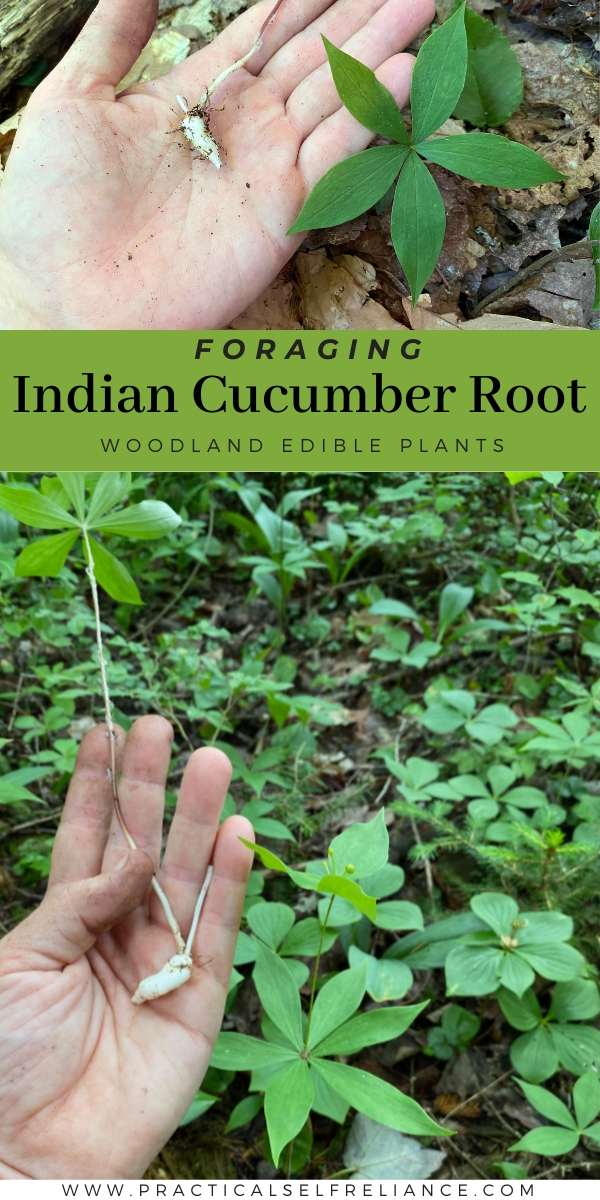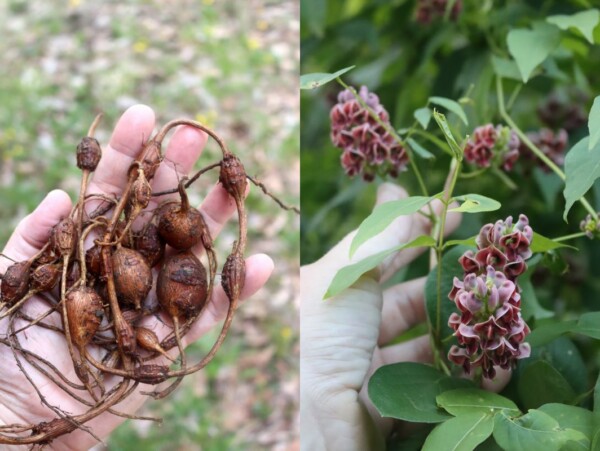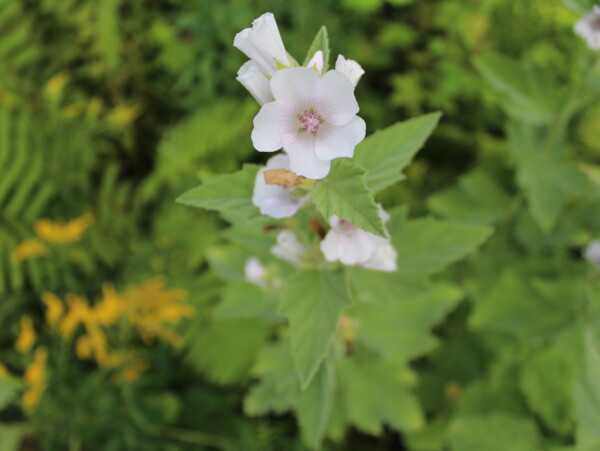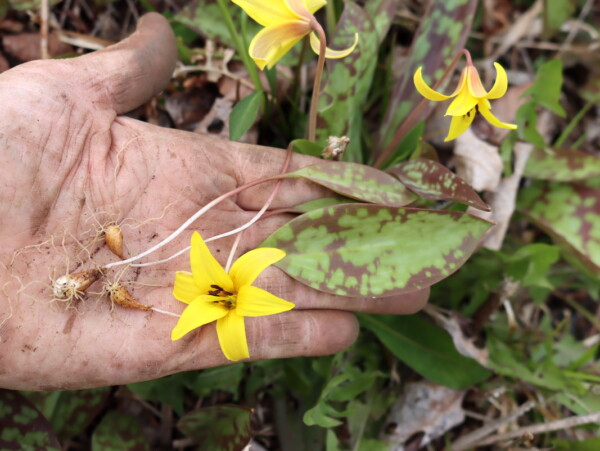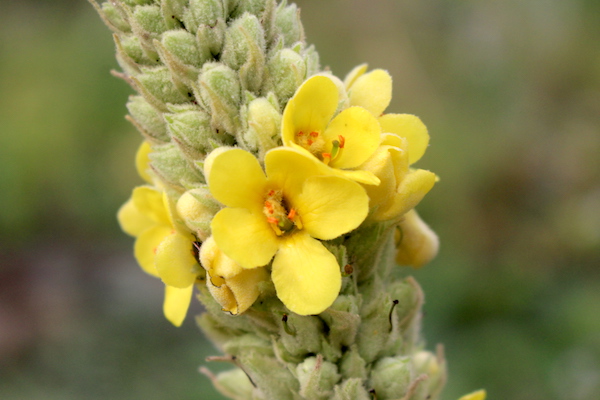Affiliate disclosure: This post may contain affiliate links. Please see our Privacy Policy.
Indian Cucumber Root (Medeola virginiana) is a small woodland wildflower in the cucumber family, and it’s named for its edible cucumber-flavored root.
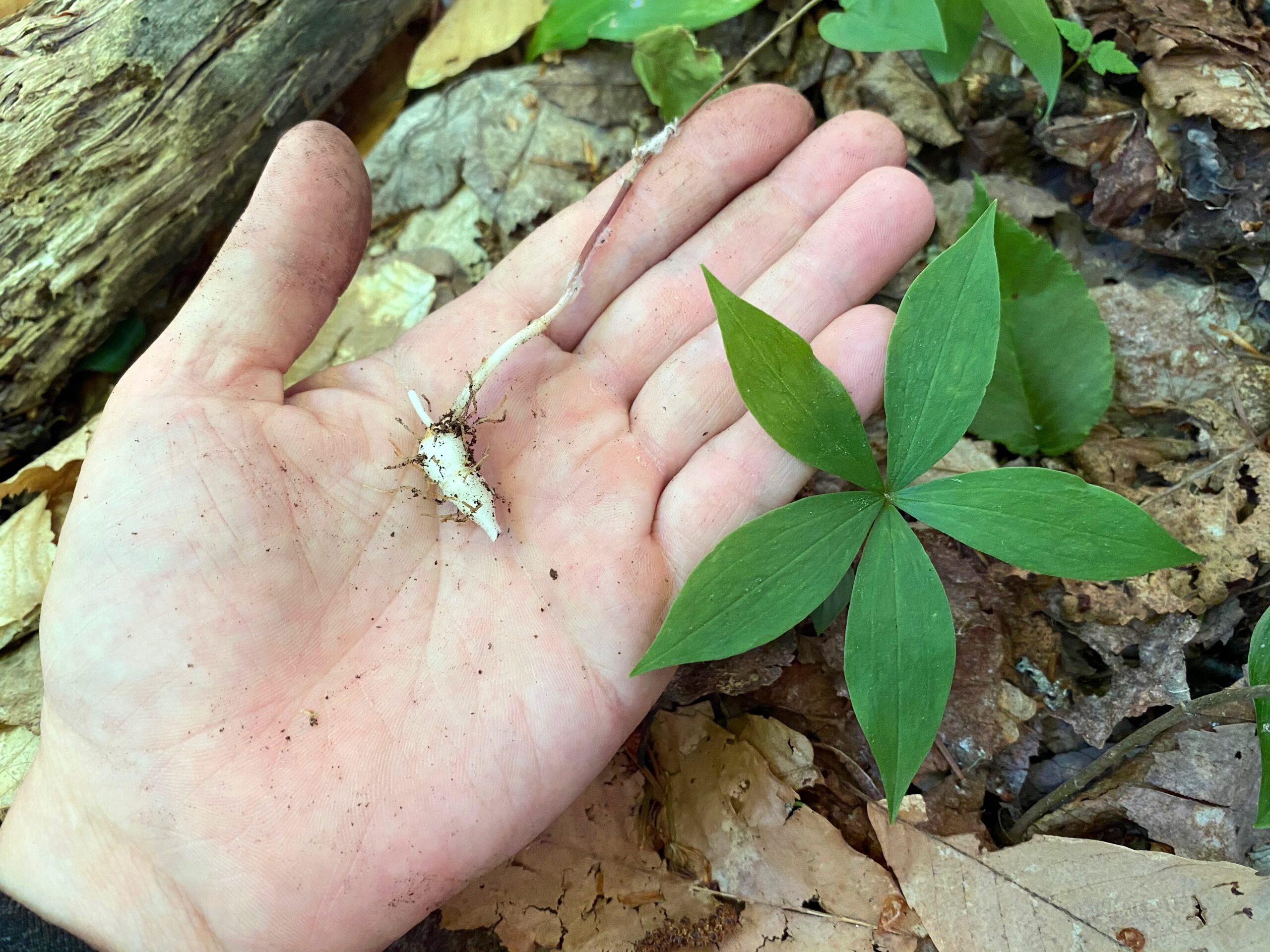
Cucumber root is a fun plant to learn to spot in the Eastern Woodland, and sometimes, in dense patches, you can even find them by smell. The whole plant has a cucumber aroma, and the edible root tastes like a crunchy, sweet cucumber. Thus, the name.
The roots are small, and even though it often carpets the woodland floor, especially near our favorite hiking trails, it’s not really a significant food source. But sometimes, foraging is more about deepening your connection with (and curiosity about) the natural world.
When you learn to identify Indian Cucumber Root, it’s not necessarily because you’re going to harvest a basket of it. You’ll be able to look at the landscape with a knowing glance, and smile to yourself as you walk, knowing that there are secret cucumbers hiding underneath the leaf litter beside the hiking path.
My kids especially appreciate this fun little plant, and just one crunchy snack years ago is enough to put a smile on their faces every time we hike near cucumber root.
Back when they were really little, I dug one up and gave it to them to try, and they loved it. “This is good! It’s so GOOD!” said my preschoolers, surpised that I’d popped something magically sweet, aromatic and cucumber-ish from the soil seemingly on a whim.
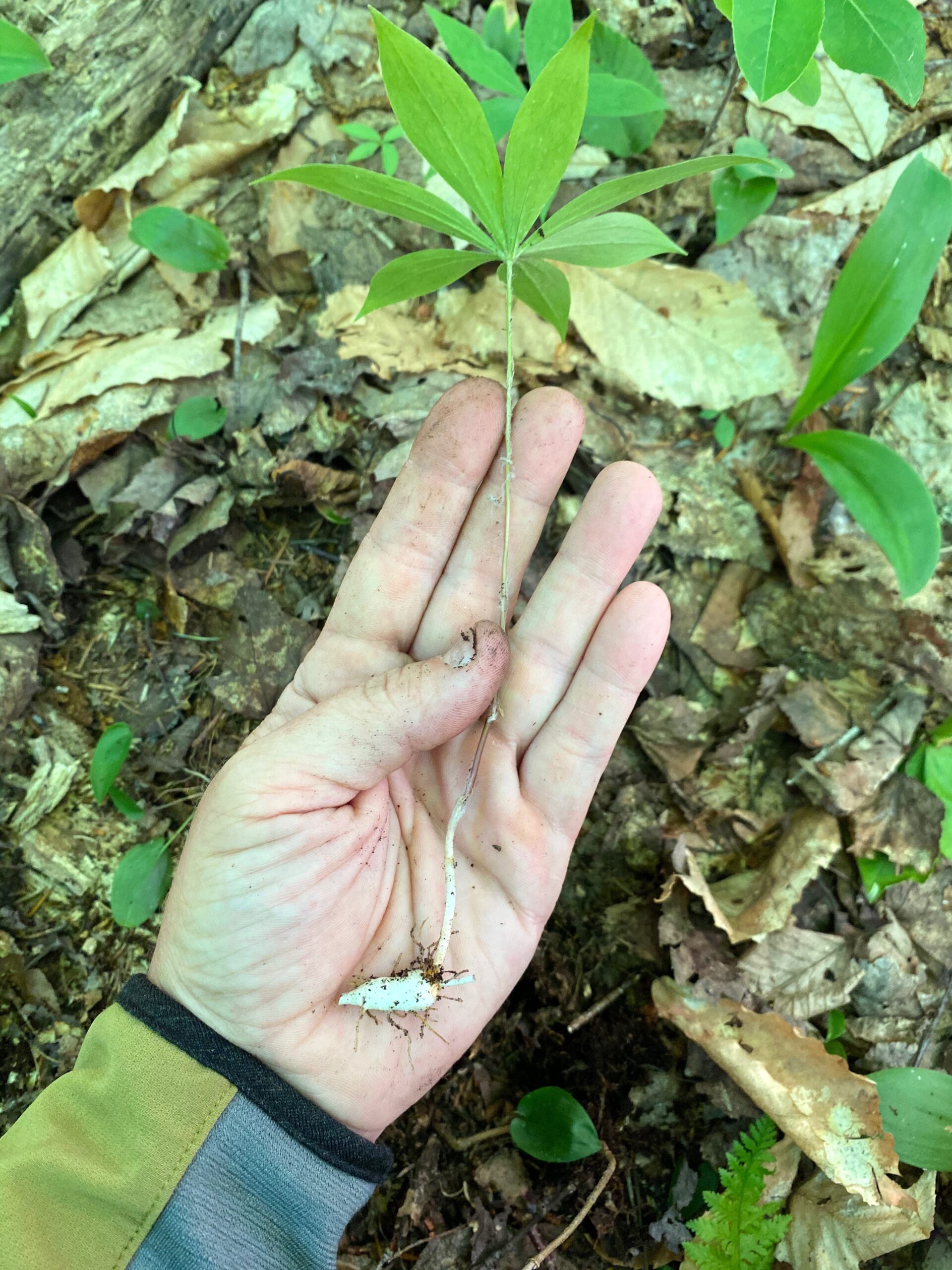
They don’t need to gorge on it or even eat these tender roots ever again, but from that day forward, they smile when they spot it and skip along the hiking path…as if there’s some deep secret they share with the woods around them. The other hikers don’t know, and the dogs running by on the trail will never guess. But there’s cucumber in these here woods!
For me, even as an adult, it’s no different. I know it’s there, and that makes the woods just a little bit more magic.
The same is true of trout lily or spring beauty, both of which also have tiny edible roots. No need to dig up those pea-sized treats, but I know they’re there, and that little nugget of information connects me to the landscape and somehow makes me feel like I’m more a part of the natural world, rather than just a visitor passing through.
The foraging world is not all about big harvests, or bringing home calories…sometimes it’s about engaging with nature, and using all your senses. And our sense of taste is powerful, creating memories and tying us to this land in deeper ways.
What is Cucumber Root?
Commonly known as Cucumber Root, Indian Cucumber, or Indian Cucumber Root, Medeola virginiana is an herbaceous perennial native to the eastern half of North America.
It’s in the Lily or Lilaceae family and is the sole member of the Medeola genus.
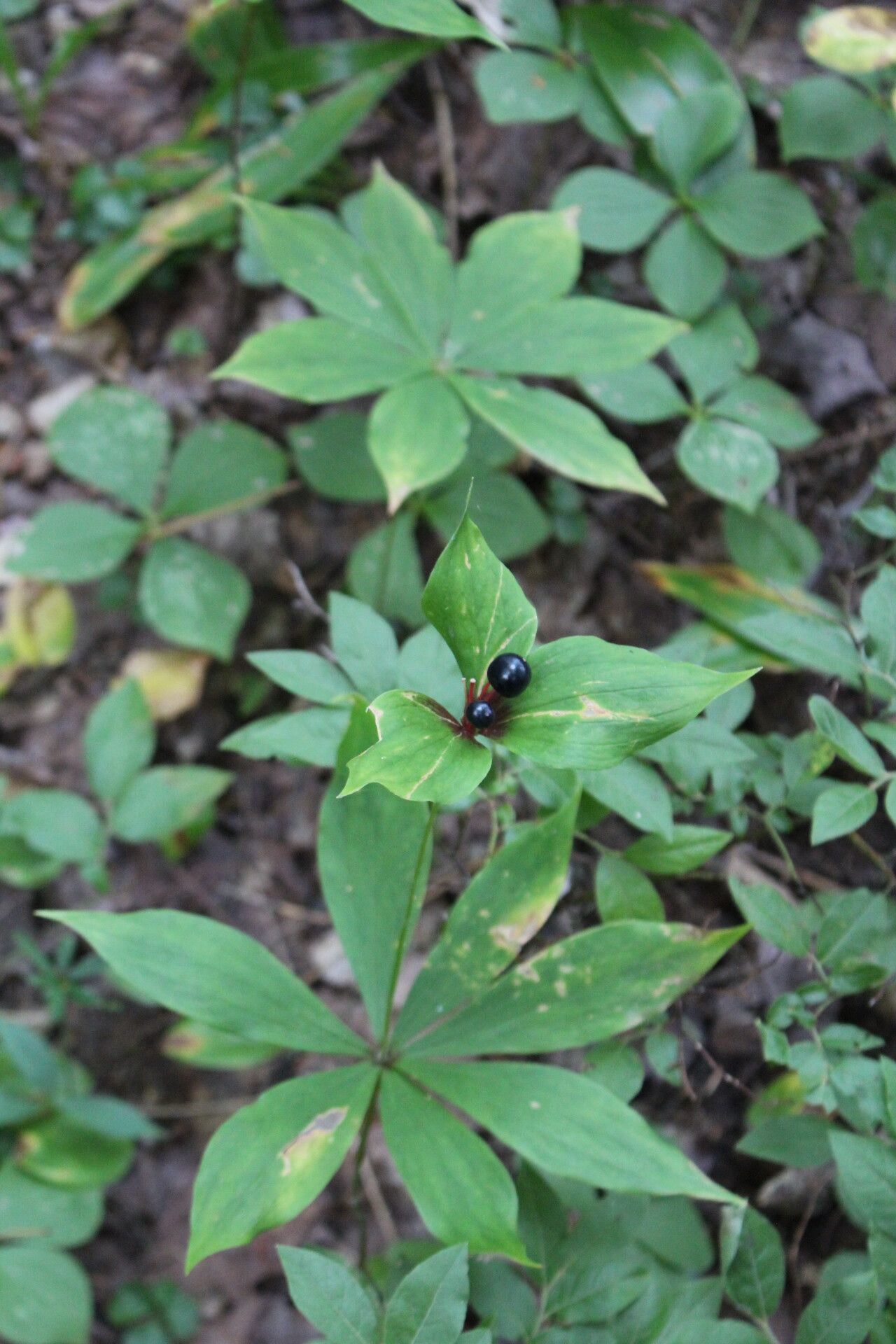
Is Cucumber Root Edible?
This plant gets its name from the tasty, edible rhizome it produces beneath the soil. Typically, people eat the rhizome raw, but you can also enjoy it cooked. Historically, herbalists may have also used the berries and leaves medicinally, but their safety isn’t verified.
Cucumber Root may have a diuretic effect. Those already taking diuretics should avoid Cucumber Root as it may lead to dehydration.
Cucumber Root is listed as endangered in Illinois and Florida and is threatened or near threatened in many other areas. Depending on its status in your area, foraging for Cucumber Root may be discouraged or even forbidden.
Where we are here in Vermont, it’s common simply because the land doesn’t face that much disturbance and it’ll carpet the ground in areas with mature forests. Since it thrives in acidic soil, we usually find it around our favorite hiking spots, in among the wild blueberries, bunchberries, teaberries and partridgeberries.
Even though it is edible, it’s not a significant food source by any means, and more of a novelty. It’s not something you’re going to harvest as anything more than a trailside snack, and knowing how to spot it is more about deepening your connection with the woodland and natural world around you than it is about finding a meal.
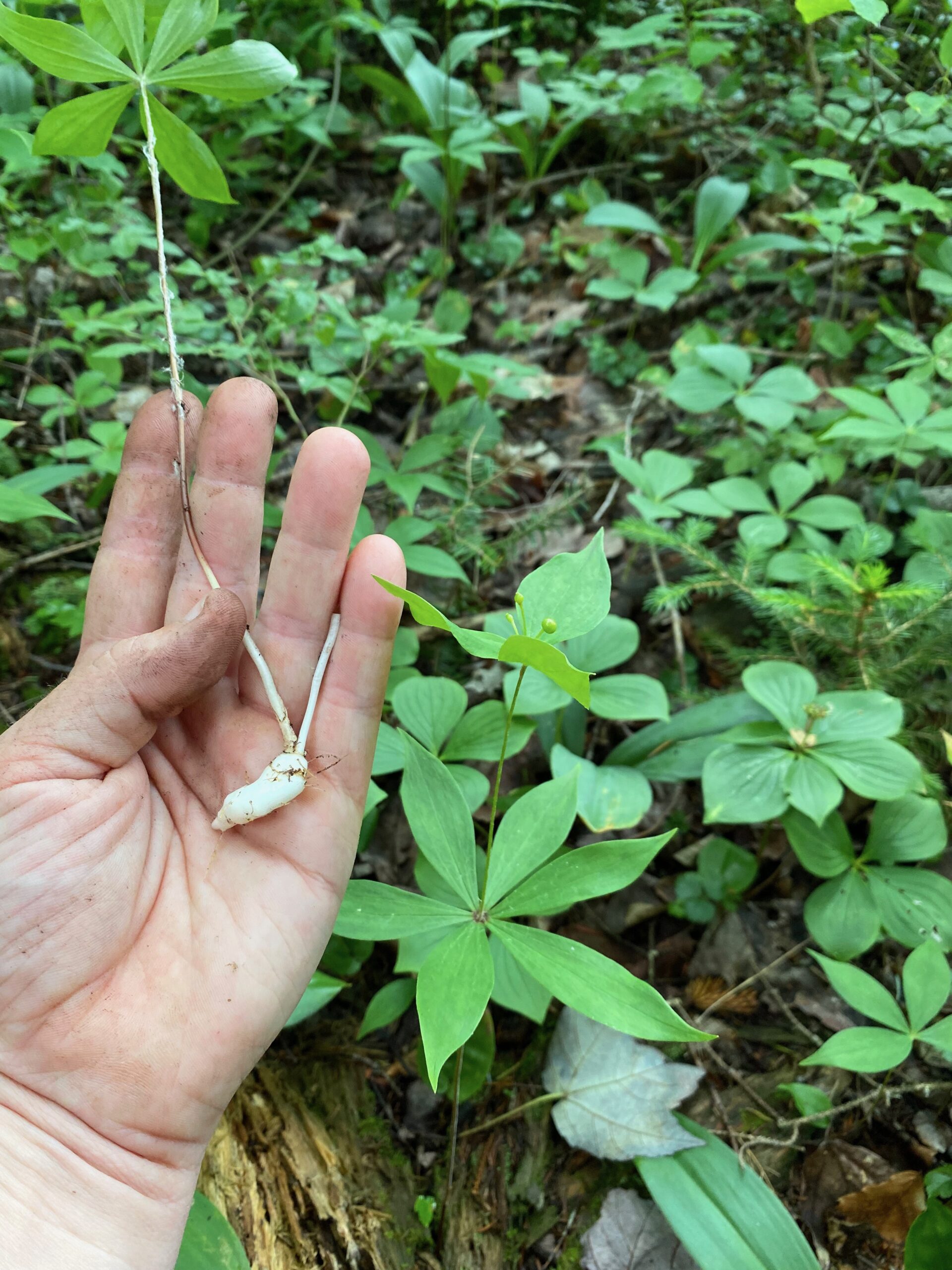
Cucumber Root Medicinal Benefits
There are limited accounts available about the historical use of Cucumber Root. However, some sources suggest that the genus name Medeola is a reference to Medea, who was a sorceress and priestess to the Goddess Hecate in Greek Mythology. Medea is sometimes connected to plant lore, prophecy, fertility, and healing.
Undoubtedly, Native Americans were the first to use and understand Cucumber Root. The Iroquois reportedly used Cucumber Root berries and leaves to treat convulsions, particularly in children. Other sources indicate that Native Americans may have used Cucumber Root as a diuretic, to induce diarrhea, and to treat dropsy or the generalized swelling associated with heart failure.
Cucumber Root hasn’t received much attention from modern herbalists or researchers. Today, foragers typically seek it out for its excellent flavor rather than its medicinal benefits.
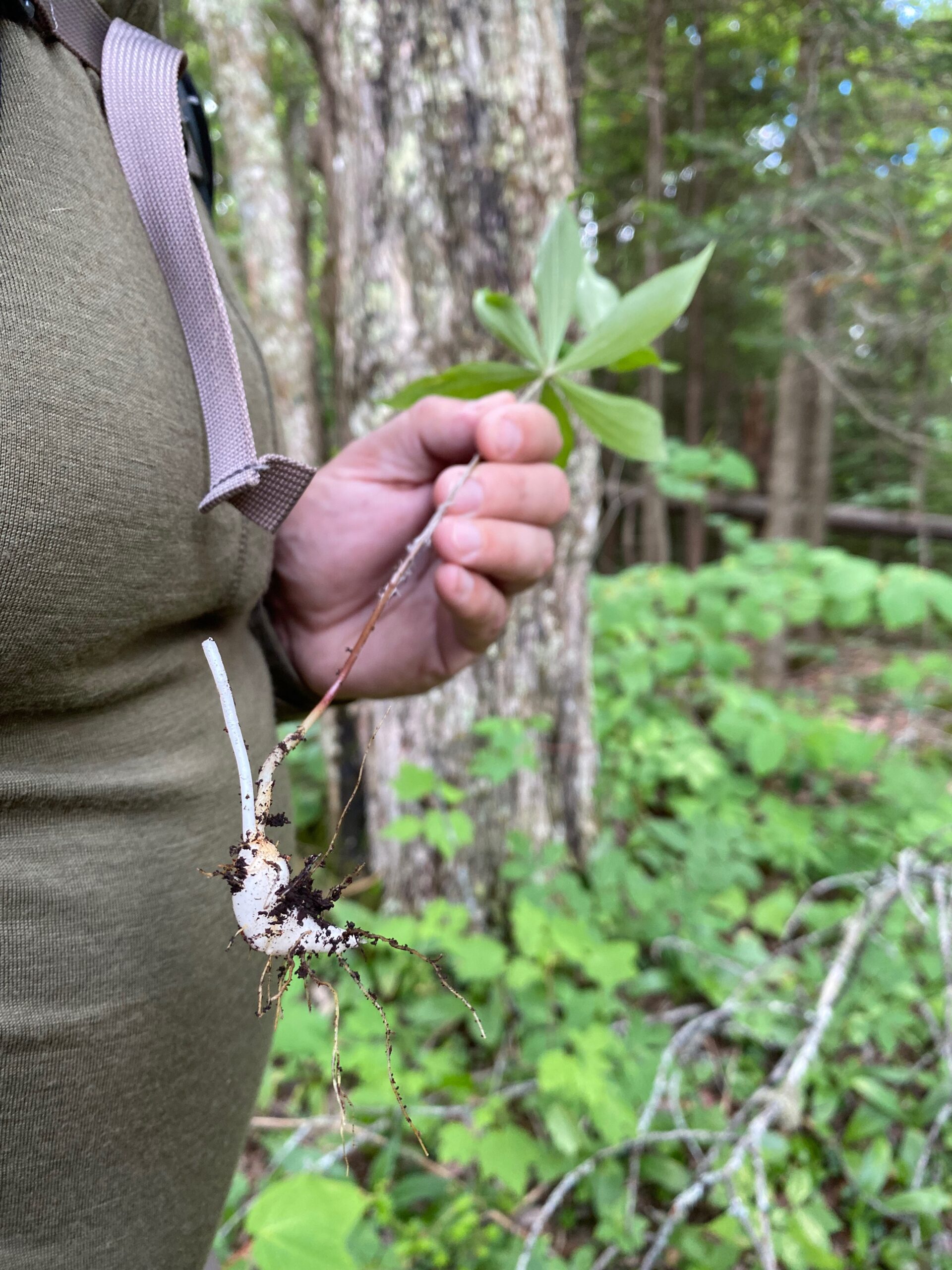
Where to Find Cucumber Root
Cucumber Root is native to the eastern half of North America. It grows from Ontario, Quebec, and Nova Scotia, south to Florida, west to Alabama, and north to Minnesota.
Cucumber Root is an understory species that grows in the shade of hardwood and mixed hardwood and coniferous forests. It thrives in well-drained, acidic soil and is usually found on slopes.
One of the reasons that Cucumber Root populations have declined is that the plant doesn’t recover well from logging and other disturbances. Recovering woodlands may not have Cucumber Root for more than 10 years after logging.
Be mindful of your surroundings, and don’t sample cucumber root except in areas where it’s abundant. Even still, this is meant to be something to sample to deepen your connection with the woods, and there’s no need to harvest more than one or two.
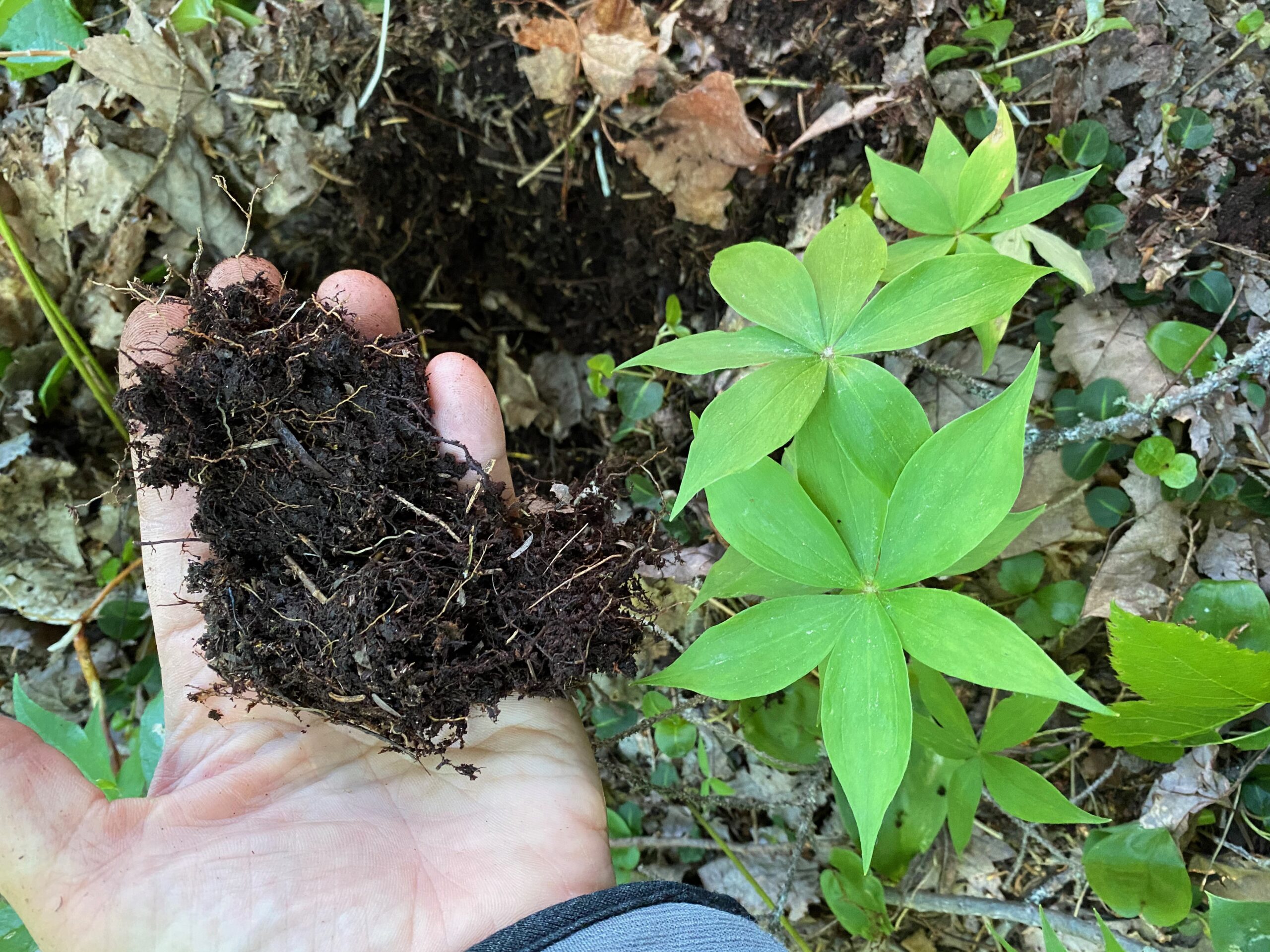
When to Find Cucumber Root
Cucumber Root emerges from the ground in March or April, with plants in southern regions usually coming up first. Mature plants will bud and then bloom between May and June. Green berries follow the flowers, ripening to blue-black in August or early September.
While roots can be harvested whenever you can find them, it’s challenging to locate them without the plant’s leaves. Therefore, it’s probably best to harvest roots for eating in early spring or fall when the leaves are visible, but the plant has put energy into the roots rather than the flowers and berries.

Identifying Cucumber Root
Cucumber Root’s whorls of leaves can help you spot it on the forest floor. It often grows in colonies as it slowly spreads through underground rhizomes. The flowers are nodding and often hidden below the leaves, but when fruiting, it may be easy to spot the blue-black berries held above the foliage. When the berries are ripe, their stems also turn red, as do the bases of the leaves, helping to catch your eye!
The entire plant often has a cucumber-like scent. Some foragers find that they can smell a colony of Cucumber Root plants as they walk near them.
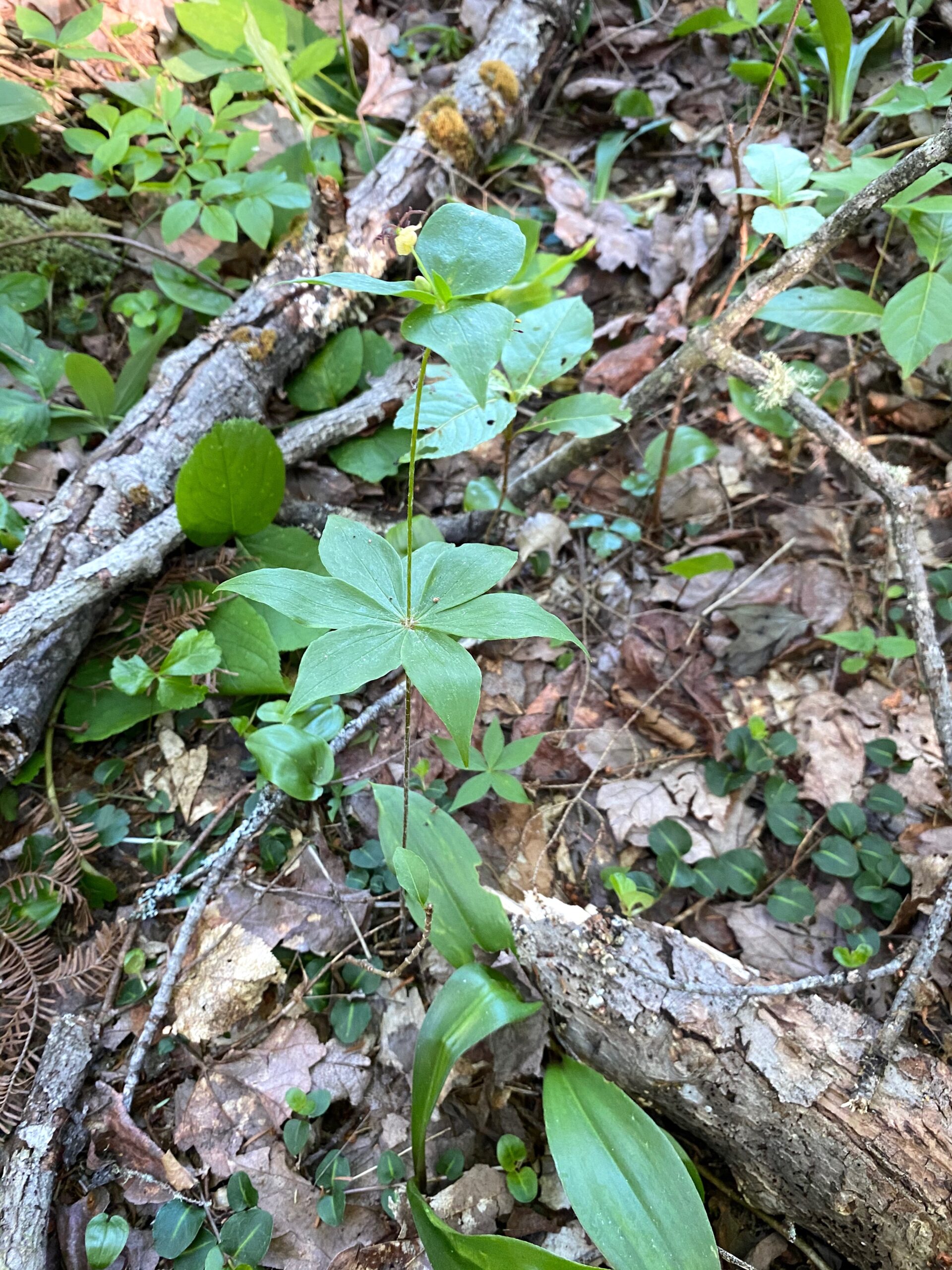
Cucumber Root Leaves
Cucumber Root has green lanceolate to ovate leaves with pointed tips. The leaves feature parallel venation or curved veins that run parallel from the base to the tip. They first emerge in March or April. Immature plants have one whorl of leaves, while sexually mature plants have two whorls.
All Cucumber Root plants have a whorl of 5 to 9 leaves that are about 5 inches long. In immature plants, this whorl is at the top of the stem, but in sexually mature plants, it is about midway up the stem. These mature plants grow to produce a second top whorl of three leaves that are about 3 inches long.
As the season goes on, Cucumber Root leaves usually change color. As the berries ripen, the center points of the whorl of leaves usually change to red, which may help draw in birds to spread the seeds in the berries.
In the fall, as the plant prepares to go dormant, its leaves often take on tinges of purplish, reddish, or brownish before the plant dies back.

Cucumber Root Stems
Cucumber Root has a hairy or wooly, unbranched, firm, wiry, green stem that grows 1 to 2 feet tall.
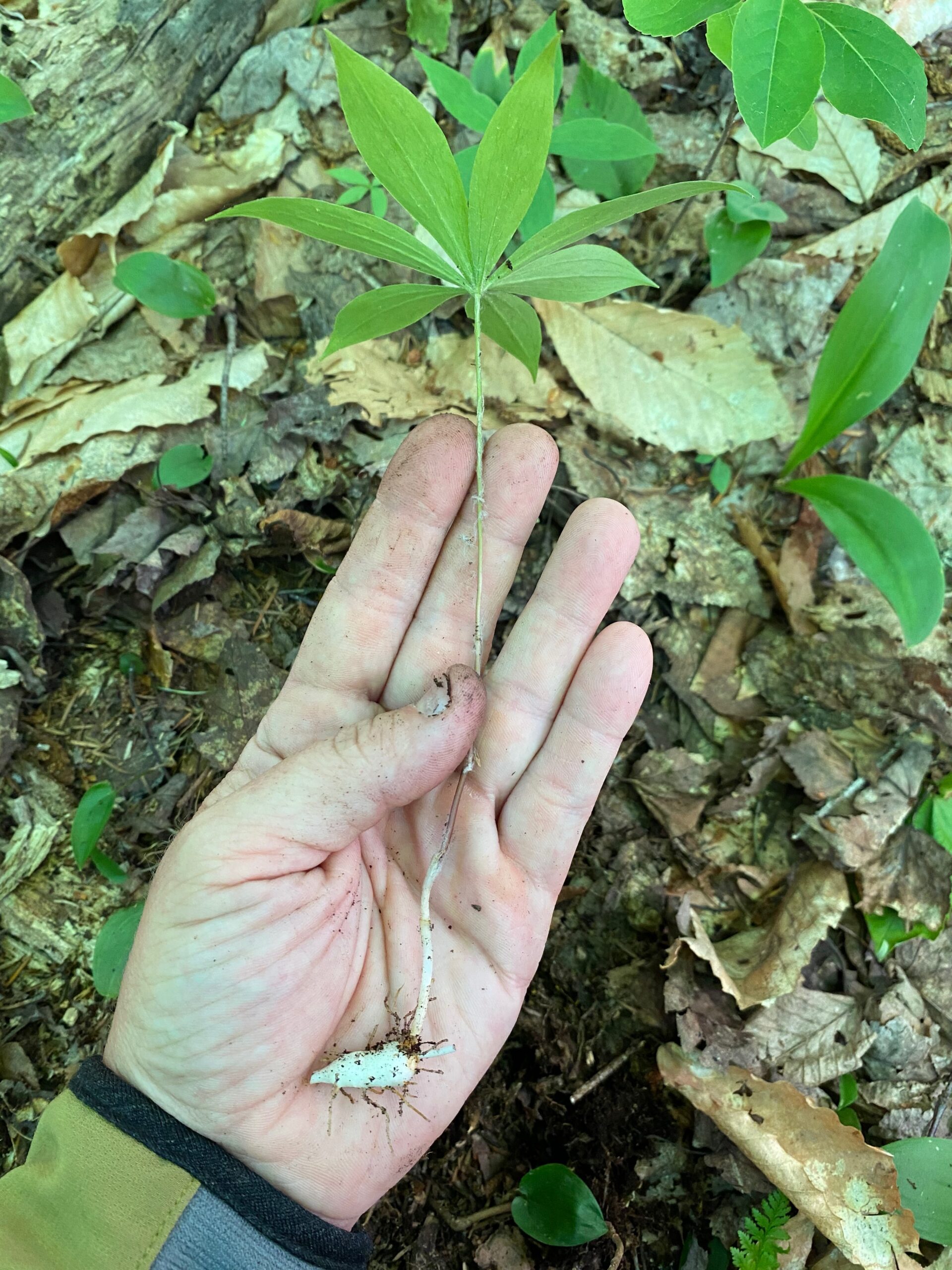
Cucumber Root Flowers
In May or June, a cluster of buds appears above the top whorl of leaves on sexually mature plants. These buds open to pale yellow or greenish flowers that droop or nod beneath the whorl of leaves.
The flowers are about ½ inch wide and have six petal-like segments that curl backward. They also have red to purplish stamens.
Eventually, these flowers curl back upwards after they’re pollinated and remain above the leaves before forming berries.
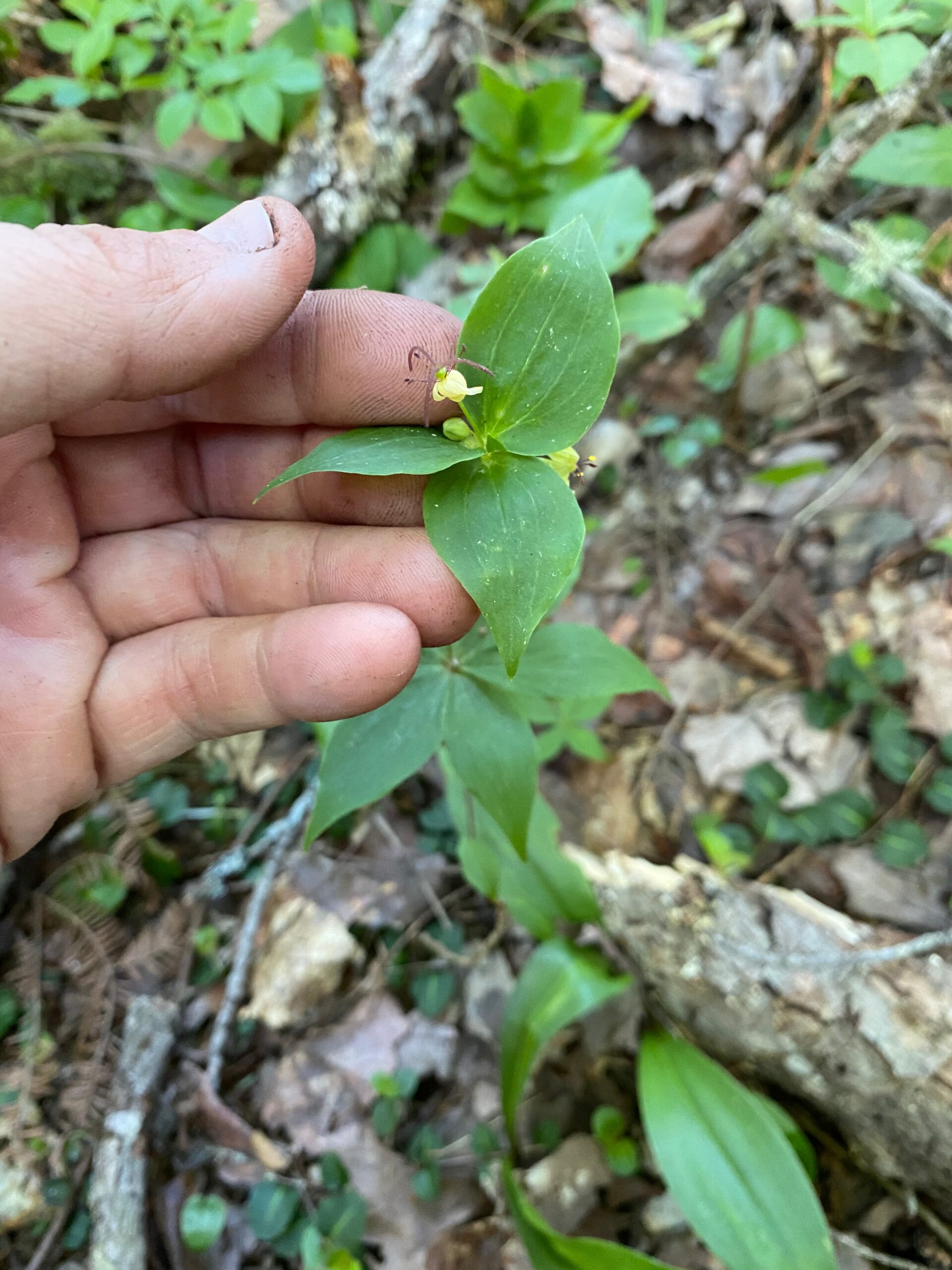
Cucumber Root Berries
The flowers give way to green berries held on stems above the top whorl of leaves.
The berries ripen to blue-black in August or early September. Each berry contains 2 to 6 hard, reddish-brown seeds.
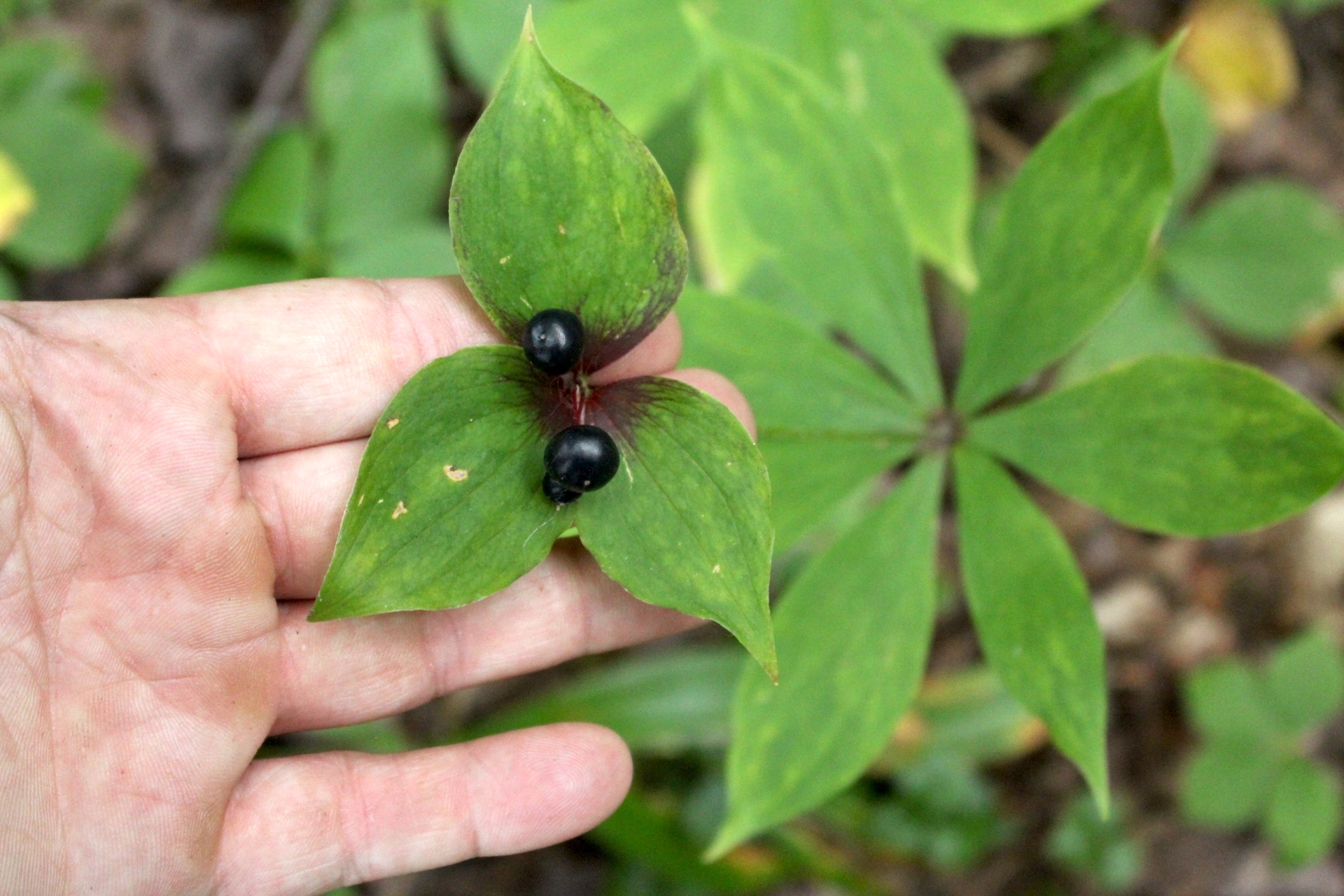
Cucumber Rhizomes
Cucumber Root is named for its edible rhizome, which may grow 2 to 3 inches long and ½ to 1 inch wide. The rhizome is white and has a brittle texture and cucumber-like scent and flavor.
These rhizomes can produce 1 to 3 lateral stolons, which send up their own shoots and eventually form their own rhizomes, creating clones of the original plant.
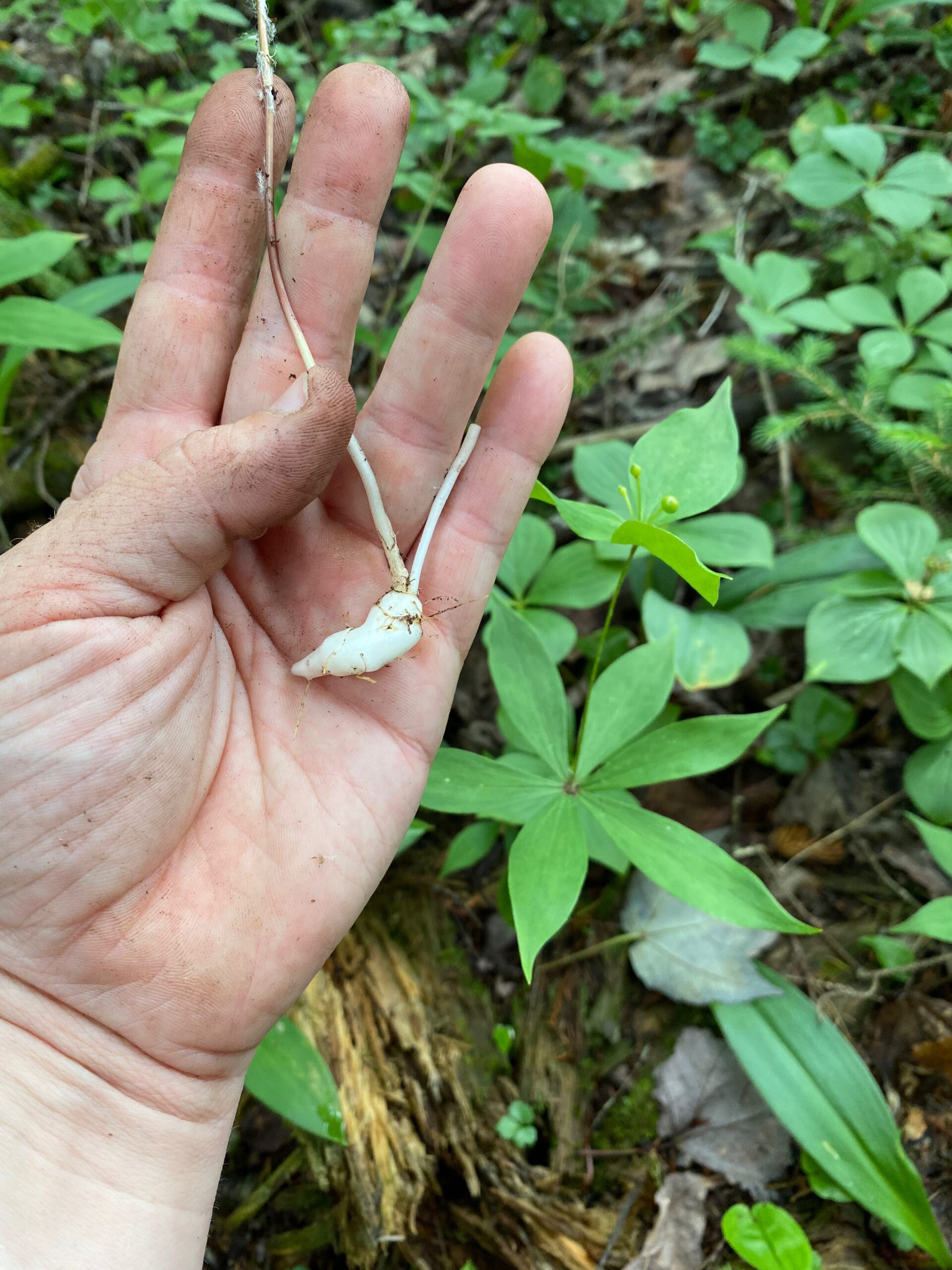
Cucumber Root Look-Alikes
Young Cucumber Root plants are easy to mistake for another common woodland flower, Starflower (Trientalis borealis). Here are a few ways to tell them apart:
- Starflower leaves feature pinnate venation, meaning that there are many secondary veins branching off from the main vein.
- Starflower produces just a single whorl of leaves.
- Starflowers have 1 to 3 white, star-shaped flowers held above the leaves.
- Starflowers typically grow just 8 inches tall.
Cucumber Root may also be confused with Small Whorled Pogonia (Isotria medeoloides). However, the two differ in a couple of noticeable ways:
- Small Whorled Pogonia has a pale, fleshy stem.
- Small Whorled Pogonia has elliptic leaves up to 3.5 inches long.
- Small Whorled Pogonia only develops one whorl of five leaves.
- Small Whorled Pogonia produces one or occasionally two greenish-yellow flowers on short stems above the leaves.
Lastly, you could confuse Cucumber Root with Nodding Trillium (Trillium cernuum). Thankfully, there are some easy ways to differentiate them:
- Nodding Trillium has a single whorl of three oval to broadly diamond-shaped leaves that may grow up to 4 inches long and wide.
- Nodding Trillium grows a single flower with three white petals and three green sepals that droops below the leaves.
- Nodding Trillium flowers are usually about 1 ½ inches wide.
- Nodding Trillium flowers have six stamens with pinkish-purple tips.
Ways to Use Cucumber Root
Cucumber Root’s name says it all! This plant’s rhizomes aren’t large, but they have a pleasant cucumber-like aroma and flavor. They’re delicious when eaten fresh and perfect for trailside snacking or adding to salads.
Some sources report the leaves and berries to be edible or have medicinal properties. Use your best judgment when experimenting with this plant, and start with small quantities.
Due to the increasing rarity of this plant, you may want to not harvest in your area. You can also learn how to propagate Cucumber Root by seed on your property for food and to help support its populations.
Cucumber Root is now absent in many parts of its native range. Nomad Seed has helpfully put together some directions for propagating Cucumber Root and encouraging it to thrive on your property.
Edible Wild Roots and Tubers
Foraging other wild roots and tubers?
- 20+ Edible wild roots, tubers, and bulbs
- Foraging Spring Beauty (Fairy Potatoes)
- Foraging Burdock
- Foraging Evening Primrose
- Foraging Mullein (yes, the root is edible)
- 12+ Dandelion Root Recipes
